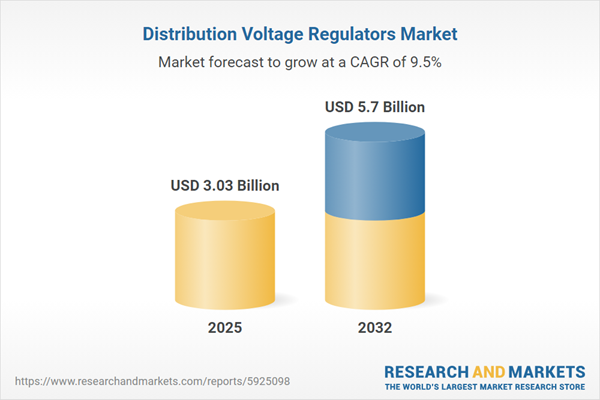Speak directly to the analyst to clarify any post sales queries you may have.
The Distribution Voltage Regulators Market is advancing rapidly as utility firms and key industries demand enhanced grid resilience and adaptive power management, driven by evolving energy sources and increased electrification across sectors.
Market Snapshot: Distribution Voltage Regulators
The Distribution Voltage Regulators Market grew from USD 2.76 billion in 2024 to USD 3.03 billion in 2025. It is expected to continue growing at a CAGR of 9.46%, reaching USD 5.70 billion by 2032. This growth is shaped by the critical need to stabilize voltage in increasingly complex power distribution systems, ensuring reliability across diverse operational environments.
Scope & Segmentation
- Type: Ferroresonant, Static
- End Use: Commercial, Industrial (Automotive, Chemicals & Petrochemicals, Manufacturing, Oil and Gas), Utility
- Manufacturing Segments: Discrete Manufacturing, Process Manufacturing
- Phase: Single-Phase, Three-Phase
- Installation: Pad-Mounted, Pole-Mounted
- Voltage Class: Low Voltage, Medium Voltage
- Geographical Coverage: Americas (United States, Canada, Mexico, Brazil, Argentina, Chile, Colombia, Peru), Europe, Middle East & Africa (United Kingdom, Germany, France, Russia, Italy, Spain, Netherlands, Sweden, Poland, Switzerland, United Arab Emirates, Saudi Arabia, Qatar, Turkey, Israel, South Africa, Nigeria, Egypt, Kenya), Asia-Pacific (China, India, Japan, Australia, South Korea, Indonesia, Thailand, Malaysia, Singapore, Taiwan)
- Key Industry Players: ABB Ltd., Siemens AG, Schneider Electric SE, General Electric Company, Eaton Corporation plc, S&C Electric Company, Schweitzer Engineering Laboratories, Inc., Mitsubishi Electric Corporation, Toshiba Corporation, Fuji Electric Co., Ltd.
Key Takeaways for Decision Makers
- Distribution voltage regulators are integral to modern grid stability, especially as energy demand grows and fluctuates with renewable integration.
- Intelligent, software-enhanced regulators now enable real-time, two-way grid communication, providing quick adaptation to network changes.
- Adoption of digital technologies and eco-friendly designs is increasing as utilities seek both operational efficiency and sustainability.
- Strategic partnerships and bundled service models are preferred, aligning performance outcomes with long-term value delivery for end-users.
- Manufacturers are shifting toward modular and locally sourced components to boost resilience against policy and supply chain shifts.
- Companies should invest in innovation hubs to tailor solutions for specific regional and regulatory needs, strengthening market agility.
Tariff Impact: Navigating New Policy Realities
The 2025 introduction of United States tariffs on imported electrical components is shifting industry dynamics. Firms are localizing supply chains and production, reinforcing domestic sourcing to balance costs. Utilities and industrial operators now prioritize lifecycle value and integrated service agreements, partnering with domestic suppliers for comprehensive support. Suppliers are innovating with standardized sub-assemblies and domestic material sourcing to mitigate the impact of regulatory changes and potential trade disruptions.
Market Dynamics and Technology Trends
Technological transformation is redefining the landscape, with static voltage regulators driven by power electronics emerging alongside traditional solutions. Integration of advanced sensors and remote diagnostics is standard, supporting predictive maintenance and reducing operational risk. Environmental goals are leading to more sustainable designs, minimizing losses and aligning with global decarbonization targets. Regionally, North America and Europe are accelerating digital upgrades, while Asia-Pacific leads in rapid industrial and infrastructure growth, demanding scale and flexibility in voltage regulation.
Methodology & Data Sources
This report is built on comprehensive secondary research, including regulatory filings, technical standards, and product specifications. Primary insights from industry leaders and procurement specialists have been integrated through interviews and structured surveys, with triangulation against performance data to ensure accuracy and relevance.
Why This Report Matters
- Senior leaders gain a detailed view of segment drivers, technology adoption, and supply chain adjustments needed for strategic market entry or expansion.
- The report delivers actionable recommendations for product design, partnership strategies, and operational agility tailored to evolving market and policy conditions.
- Stakeholders are equipped to anticipate regulatory shifts, assess investment opportunities, and optimize resource allocation for sustained competitive advantage.
Conclusion
The Distribution Voltage Regulators Market is evolving to meet the challenges of grid modernization, renewable integration, and regulatory change. Strategic alignment and investment in advanced, flexible solutions will enable organizations to lead in this critical sector.
Additional Product Information:
- Purchase of this report includes 1 year online access with quarterly updates.
- This report can be updated on request. Please contact our Customer Experience team using the Ask a Question widget on our website.
Table of Contents
3. Executive Summary
4. Market Overview
7. Cumulative Impact of Artificial Intelligence 2025
Companies Mentioned
The companies profiled in this Distribution Voltage Regulators market report include:- ABB Ltd.
- Siemens AG
- Schneider Electric SE
- General Electric Company
- Eaton Corporation plc
- S&C Electric Company
- Schweitzer Engineering Laboratories, Inc.
- Mitsubishi Electric Corporation
- Toshiba Corporation
- Fuji Electric Co., Ltd.
Table Information
| Report Attribute | Details |
|---|---|
| No. of Pages | 183 |
| Published | November 2025 |
| Forecast Period | 2025 - 2032 |
| Estimated Market Value ( USD | $ 3.03 Billion |
| Forecasted Market Value ( USD | $ 5.7 Billion |
| Compound Annual Growth Rate | 9.4% |
| Regions Covered | Global |
| No. of Companies Mentioned | 11 |









